Response of Vegetation Productivity to Greening and Drought in the Loess Plateau Based on VIs and SIF
Abstract
1. Introduction
2. Materials and Methods
2.1. Study Area
2.2. Data
2.2.1. Solar-Induced Chlorophyll Fluorescence (SIF) Data
2.2.2. MODIS Product Data
2.2.3. Drought Index and Meteorological Data
2.3. Methodology
2.3.1. Trend Analysis and Significance Tests
2.3.2. Correlation of GPP with VIs and SIF
3. Results
3.1. Drought Characteristics of the Loess Plateau
3.1.1. Spatial and Temporal Variability of Drought
3.1.2. Characteristics of the 2001 Drought
3.2. Greening Characteristics of the Loess Plateau
3.3. Relationship of GPP with VIs and SIF, 2001–2020
3.3.1. Correlation of GPP with VIs
3.3.2. Correlation between GPP and SIF
3.4. Capture of GPP by VIs and SIF in Dry Years
3.4.1. SIF Responds Better Than VIs to Drought
3.4.2. Capture of GPP Changes by VIs and SIF
4. Discussion
4.1. Changing Trends in the Loess Plateau
4.2. Response of VIs and SIF to Drought
4.3. GPP with VIs and SIF
4.3.1. Correlation at Different Time Scales
4.3.2. Capture during Droughts
5. Conclusions
- (1)
- Based on the spatial and temporal changes of SPEI and SSMI from 2001 to 2020, it was found that the overall drought in the Loess Plateau showed a decreasing trend. However, in the forest, SSMI showed an increasing drought trend. May–July 2001 was identified as a drought event.
- (2)
- The trends of changes in VIs, SIF, and GPP from 2001 to 2020 are basically the same, and all of them show an upward trend. However, only SIF and NIRV reflected the phenomenon that the GPP of deciduous forests was higher than that of evergreen forests.
- (3)
- Both VIs and SIF were subjected to drought stress during the peak vegetation growth season during drought events, but SIF more accurately captured drought signals and the initial stages of drought.
- (4)
- In the relationship of GPP with VIs and SIF at different time scales, SIF (meanR2 = 0.85) performed the best, followed in descending order by NIRV (meanR2 = 0.84), NDVI (meanR2 = 0.76), and kNDVI (meanR2 = 0.74). Notably, it is worth noting that kNDVI performs best in sparse vegetation (meanR2 = 0.85). NIRV is the most stable of the three VIs and is closest to SIF.
- (5)
- In the capture of GPP by VIs and SIF during drought, NIRV and kNDVI performed better in the land classes with low productivity; with the increase in land use classes productivity, SIF showed better capturing ability. In addition, the capture of GPP anomalies was best for kNDVI (meanR2 = 0.50), followed by NIRV (meanR2 = 0.37), NDVI (meanR2 = 0.35), and SIF (meanR2 = 0.26).
Author Contributions
Funding
Data Availability Statement
Acknowledgments
Conflicts of Interest
References
- Beer, C.; Reichstein, M.; Tomelleri, E.; Ciais, P.; Jung, M.; Carvalhais, N.; Rödenbeck, C.; Arain, M.A.; Baldocchi, D.; Bonan, G.B.; et al. Terrestrial Gross Carbon Dioxide Uptake: Global Distribution and Covariation with Climate. Science 2010, 329, 834–838. [Google Scholar] [CrossRef]
- Anav, A.; Friedlingstein, P.; Beer, C.; Ciais, P.; Harper, A.; Jones, C.; Murray-Tortarolo, G.; Papale, D.; Parazoo, N.C.; Peylin, P.; et al. Spatiotemporal Patterns of Terrestrial Gross Primary Production: A Review. Rev. Geophys. 2015, 53, 785–818. [Google Scholar] [CrossRef]
- Rockström, J.; Steffen, W.; Noone, K.; Persson, Å.; Chapin, F.S.; Lambin, E.F.; Lenton, T.M.; Scheffer, M.; Folke, C.; Schellnhuber, H.J.; et al. A Safe Operating Space for Humanity. Nature 2009, 461, 472–475. [Google Scholar] [CrossRef]
- Running, S.W. A Measurable Planetary Boundary for the Biosphere. Science 2012, 337, 1458–1459. [Google Scholar] [CrossRef]
- Chen, C.; Park, T.; Wang, X.; Piao, S.; Xu, B.; Chaturvedi, R.K.; Fuchs, R.; Brovkin, V.; Ciais, P.; Fensholt, R.; et al. China and India Lead in Greening of the World through Land-Use Management. Nat. Sustain. 2019, 2, 122–129. [Google Scholar] [CrossRef]
- Piao, S.; Wang, X.; Park, T.; Chen, C.; Lian, X.; He, Y.; Bjerke, J.W.; Chen, A.; Ciais, P.; Tømmervik, H.; et al. Characteristics, Drivers and Feedbacks of Global Greening. Nat. Rev. Earth Environ. 2019, 1, 14–27. [Google Scholar] [CrossRef]
- Yang, Y.; Shi, Y.; Sun, W.; Chang, J.; Zhu, J.; Chen, L.; Wang, X.; Guo, Y.; Zhang, H.; Yu, L.; et al. Terrestrial Carbon Sinks in China and around the World and Their Contribution to Carbon Neutrality. Sci. China Life Sci. 2022, 65, 861–895. [Google Scholar] [CrossRef] [PubMed]
- Yang, Y.; Roderick, M.L.; Guo, H.; Miralles, D.G.; Zhang, L.; Fatichi, S.; Luo, X.; Zhang, Y.; McVicar, T.R.; Tu, Z.; et al. Evapotranspiration on a Greening Earth. Nat. Rev. Earth Environ. 2023, 4, 626–641. [Google Scholar] [CrossRef]
- Shao, D.; Chen, S.; Tan, X.; Gu, W. Drought Characteristics over China during 1980–2015. Int. J. Climatol. 2018, 38, 3532–3545. [Google Scholar] [CrossRef]
- Zhao, Z.; Zhang, B.; Pan, L.; Niu, P.; Guo, J. Diagnosis and Prediction of Drought in Eastern Inner Mongolia Based on SPEI. Environ. Ecol. 2023, 5, 39–48. [Google Scholar]
- Zeng, Z.; Wu, W.; Li, Y.; Huang, C.; Zhang, X.; Peñuelas, J.; Zhang, Y.; Gentine, P.; Li, Z.; Wang, X.; et al. Increasing Meteorological Drought under Climate Change Reduces Terrestrial Ecosystem Productivity and Carbon Storage. One Earth 2023, 6, 1326–1339. [Google Scholar] [CrossRef]
- World Meteorological Organization (WMO). Drought Monitoring and Early Warning: Concepts, Progress and Future Challenges; WMO No. 1006; World Meteorological Organization (WMO): Geneva, Switzerland, 2006; Available online: http://www.wamis.org/agm/pubs/brochures/WMO1006e.pdf (accessed on 30 January 2024).
- Xu, M.; Zhang, T.; Zhang, Y.; Chen, N.; Zhu, J.; He, Y.; Zhao, T.; Yu, G. Drought Limits Alpine Meadow Productivity in Northern Tibet. Agric. For. Meteorol. 2021, 303, 108371. [Google Scholar] [CrossRef]
- Zhao, M.; Running, S.W. Response to Comments on “Drought-Induced Reduction in Global Terrestrial Net Primary Production from 2000 through 2009”. Science 2011, 333, 1093. [Google Scholar] [CrossRef]
- Frank, D.; Reichstein, M.; Bahn, M.; Thonicke, K.; Frank, D.; Mahecha, M.D.; Smith, P.; Van Der Velde, M.; Vicca, S.; Babst, F.; et al. Effects of Climate Extremes on the Terrestrial Carbon Cycle: Concepts, Processes and Potential Future Impacts. Glob. Change Biol. 2015, 21, 2861–2880. [Google Scholar] [CrossRef]
- Piao, S.; He, Y.; Wang, X.; Chen, F. Estimation of China’s terrestrial ecosystem carbon sink: Methods, progress and prospects. Sci. China Earth Sci. 2022, 65, 641–651. [Google Scholar] [CrossRef]
- Baldocchi, D.; Falge, E.; Gu, L.; Olson, R.; Hollinger, D.; Running, S.; Anthoni, P.; Bernhofer, C.; Davis, K.; Evans, R.; et al. FLUXNET: A New Tool to Study the Temporal and Spatial Variability of Ecosystem–Scale Carbon Dioxide, Water Vapor, and Energy Flux Densities. Bull. Am. Meteorol. Soc. 2001, 82, 2415–2434. [Google Scholar] [CrossRef]
- Qiu, R.; Han, G.; Ma, X.; Xu, H.; Shi, T.; Zhang, M. A Comparison of OCO-2 SIF, MODIS GPP, and GOSIF Data from Gross Primary Production (GPP) Estimation and Seasonal Cycles in North America. Remote Sens. 2020, 12, 258. [Google Scholar] [CrossRef]
- Khalifa, M.; Elagib, N.A.; Ribbe, L.; Schneider, K. Spatio-Temporal Variations in Climate, Primary Productivity and Efficiency of Water and Carbon Use of the Land Cover Types in Sudan and Ethiopia. Sci. Total Environ. 2018, 624, 790–806. [Google Scholar] [CrossRef]
- Wang, X.; Biederman, J.A.; Knowles, J.F.; Scott, R.L.; Turner, A.J.; Dannenberg, M.P.; Köhler, P.; Frankenberg, C.; Litvak, M.E.; Flerchinger, G.N.; et al. Satellite Solar-Induced Chlorophyll Fluorescence and near-Infrared Reflectance Capture Complementary Aspects of Dryland Vegetation Productivity Dynamics. Remote Sens. Environ. 2022, 270, 112858. [Google Scholar] [CrossRef]
- Huang, X.; Xiao, J.; Ma, M. Evaluating the Performance of Satellite-Derived Vegetation Indices for Estimating Gross Primary Productivity Using FLUXNET Observations across the Globe. Remote Sens. 2019, 11, 1823. [Google Scholar] [CrossRef]
- Badgley, G.; Field, C.B.; Berry, J.A. Canopy Near-Infrared Reflectance and Terrestrial Photosynthesis. Sci. Adv. 2017, 3, e1602244. [Google Scholar] [CrossRef]
- Camps-Valls, G.; Campos-Taberner, M.; Moreno-Martínez, Á.; Walther, S.; Duveiller, G.; Cescatti, A.; Mahecha, M.D.; Muñoz-Marí, J.; García-Haro, F.J.; Guanter, L.; et al. A Unified Vegetation Index for Quantifying the Terrestrial Biosphere. Sci. Adv. 2021, 7, eabc7447. [Google Scholar] [CrossRef]
- Badgley, G.; Anderegg, L.D.L.; Berry, J.A.; Field, C.B. Terrestrial Gross Primary Production: Using NIR V to Scale from Site to Globe. Glob. Chang. Biol. 2019, 25, 3731–3740. [Google Scholar] [CrossRef] [PubMed]
- Frankenberg, C.; Fisher, J.B.; Worden, J.; Badgley, G.; Saatchi, S.S.; Lee, J.-E.; Toon, G.C.; Butz, A.; Jung, M.; Kuze, A.; et al. New Global Observations of the Terrestrial Carbon Cycle from GOSAT: Patterns of Plant Fluorescence with Gross Primary Productivity. Geophys. Res. Lett. 2011, 38, 17. [Google Scholar] [CrossRef]
- Frankenberg, C.; O’Dell, C.; Berry, J.; Guanter, L.; Joiner, J.; Köhler, P.; Pollock, R.; Taylor, T.E. Prospects for Chlorophyll Fluorescence Remote Sensing from the Orbiting Carbon Observatory-2. Remote Sens. Environ. 2014, 147, 1–12. [Google Scholar] [CrossRef]
- Joiner, J.; Guanter, L.; Lindstrot, R.; Voigt, M.; Vasilkov, A.P.; Middleton, E.M.; Huemmrich, K.F.; Yoshida, Y.; Frankenberg, C. Global Monitoring of Terrestrial Chlorophyll Fluorescence from Moderate-Spectral-Resolution near-Infrared Satellite Measurements: Methodology, Simulations, and Application to GOME-2. Atmos. Meas. Tech. 2013, 6, 2803–2823. [Google Scholar] [CrossRef]
- Li, X.; Xiao, J. A Global, 0.05-Degree Product of Solar-Induced Chlorophyll Fluorescence Derived from OCO-2, MODIS, and Reanalysis Data. Remote Sens. 2019, 11, 517. [Google Scholar] [CrossRef]
- Sun, Y.; Frankenberg, C.; Wood, J.D.; Schimel, D.S.; Jung, M.; Guanter, L.; Drewry, D.T.; Verma, M.; Porcar-Castell, A.; Griffis, T.J.; et al. OCO-2 Advances Photosynthesis Observation from Space via Solar-Induced Chlorophyll Fluorescence. Science 2017, 358, eaam5747. [Google Scholar] [CrossRef]
- Qiu, R.; Li, X.; Han, G.; Xiao, J.; Ma, X.; Gong, W. Monitoring Drought Impacts on Crop Productivity of the U.S. Midwest with Solar-Induced Fluorescence: GOSIF Outperforms GOME-2 SIF and MODIS NDVI, EVI, and NIRV. Agric. For. Meteorol. 2022, 323, 109038. [Google Scholar] [CrossRef]
- Daumard, F.; Champagne, S.; Fournier, A.; Goulas, Y.; Ounis, A.; Hanocq, J.-F.; Moya, I. A Field Platform for Continuous Measurement of Canopy Fluorescence. IEEE Trans. Geosci. Remote Sens. 2010, 48, 3358–3368. [Google Scholar] [CrossRef]
- Flexas, J.; Escalona, J.M.; Evain, S.; Gulías, J.; Moya, I.; Osmond, C.B.; Medrano, H. Steady-state Chlorophyll Fluorescence (Fs) Measurements as a Tool to Follow Variations of Net CO 2 Assimilation and Stomatal Conductance during Water-stress in C 3 Plants. Physiol. Plant. 2002, 114, 231–240. [Google Scholar] [CrossRef]
- Dobrowski, S.; Pushnik, J.; Zarcotejada, P.; Ustin, S. Simple Reflectance Indices Track Heat and Water Stress-Induced Changes in Steady-State Chlorophyll Fluorescence at the Canopy Scale. Remote Sens. Environ. 2005, 97, 403–414. [Google Scholar] [CrossRef]
- Wang, C.; Wu, X.; Fu, B.; Han, X.; Chen, Y.; Wang, K.; Zhou, H.; Feng, X.; Li, Z. Ecological restoration in the key ecologically vulnerable regions: Current situation and development direction. Acta Ecol. Sin. 2019, 39, 7333–7343. [Google Scholar] [CrossRef]
- Fu, B.; Wu, X.; Wang, Z.; Wu, X.; Wang, S. Coupling Human and Natural Systems for Sustainability: Experience from China’s Loess Plateau. Earth Syst. Dyn. 2022, 13, 795–808. [Google Scholar] [CrossRef]
- Fu, B.; Wang, S.; Liu, Y.; Liu, J.; Liang, W.; Miao, C. Hydrogeomorphic Ecosystem Responses to Natural and Anthropogenic Changes in the Loess Plateau of China. Annu. Rev. Earth Planet. Sci. 2017, 45, 223–243. [Google Scholar] [CrossRef]
- Bryan, B.A.; Gao, L.; Ye, Y.; Sun, X.; Connor, J.D.; Crossman, N.D.; Stafford-Smith, M.; Wu, J.; He, C.; Yu, D.; et al. China’s Response to a National Land-System Sustainability Emergency. Nature 2018, 559, 193–204. [Google Scholar] [CrossRef]
- Yu, Y.; Zhao, W.; Martinez-Murillo, J.F.; Pereira, P. Loess Plateau: From Degradation to Restoration. Sci. Total Environ. 2020, 738, 140206. [Google Scholar] [CrossRef] [PubMed]
- Naeem, S.; Zhang, Y.; Zhang, X.; Tian, J.; Abbas, S.; Luo, L.; Meresa, H.K. Both Climate and Socioeconomic Drivers Contribute to Vegetation Greening of the Loess Plateau. Sci. Bull. 2021, 66, 1160–1163. [Google Scholar] [CrossRef] [PubMed]
- Wu, X.; Wang, S.; Fu, B.; Feng, X.; Chen, Y. Socio-Ecological Changes on the Loess Plateau of China after Grain to Green Program. Sci. Total Environ. 2019, 678, 565–573. [Google Scholar] [CrossRef]
- Sun, Y.; Liu, X.; Ren, Z.; Li, S. Spatiotemporal Variations of Multi-Scale Drought and Its Influencing Factors across the Loess Plateau from 1960 to 2016. Geogr. Res. 2019, 38, 1820–1832. [Google Scholar]
- Wang, Y.; Shi, H.; Jiang, Y.; Wu, Y.; Gao, Y.; Ding, C. Spatio-Temporal Variation of Drought Characteristics and Its Influence Factors in Loess Plateau Based on TVDI. Trans. Chin. Soc. Agric. Mach. 2023, 54, 184–196. [Google Scholar] [CrossRef]
- Li, Y. Spatiotemporal Changes and Influencing Factors of Vegetation Cover on the Loess Plateau from 2000 to 2018. Sci. Soil Water Conserv. 2021, 19, 60–84. [Google Scholar] [CrossRef]
- Zastrow, M. China’s Tree-Planting Drive Could Falter in a Warming World. Nature 2019, 573, 474–475. [Google Scholar] [CrossRef]
- Cao, Y.Q.; Zhou, S.H.; Yang, X.T. Vegetation dynamics and its response to climate change in Liaoning Province in last 20 years. Acta Ecol. Sin. 2022, 42, 5966–5979. [Google Scholar] [CrossRef]
- Vicente-Serrano, S.M.; Beguería, S.; López-Moreno, J.I.; Angulo, M.; El Kenawy, A. A New Global 0.5° Gridded Dataset (1901–2006) of a Multiscalar Drought Index: Comparison with Current Drought Index Datasets Based on the Palmer Drought Severity Index. J. Hydrometeorol. 2010, 11, 1033–1043. [Google Scholar] [CrossRef]
- Xia, H.; Zhao, X.; Zhao, W. High-Resolution SPEI Dataset for Drought Monitoring and Impact Analysis in Mainland China from 2001 to 2020. Natl. Ecosyst. Data Bank 2023. [Google Scholar] [CrossRef]
- Vicente-Serrano, S.M.; Beguería, S.; López-Moreno, J.I. A Multiscalar Drought Index Sensitive to Global Warming: The Standardized Precipitation Evapotranspiration Index. J. Clim. 2010, 23, 1696–1718. [Google Scholar] [CrossRef]
- Roderick, M.L.; Greve, P.; Farquhar, G.D. On the Assessment of Aridity with Changes in Atmospheric CO2. Water Resour. Res. 2015, 51, 5450–5463. [Google Scholar] [CrossRef]
- Greve, P.; Roderick, M.L.; Ukkola, A.M.; Wada, Y. The Aridity Index under Global Warming. Environ. Res. Lett. 2019, 14, 124006. [Google Scholar] [CrossRef]
- Zhou, H.K.; Wu, J.J.; Li, X.H.; Liu, L.Z.; Yang, J.H.; Han, X.Y. Suitability of Assimilated Data-Based Standardized Soil Moisture Index for Agricultural Drought Monitoring. Acta Ecol. Sin. 2019, 39, 2191–2202. [Google Scholar] [CrossRef]
- Zheng, C.; Jia, L.; Zhao, T. A 21-Year Dataset (2000–2020) of Gap-Free Global Daily Surface Soil Moisture at 1-km Grid Resolution. Sci. Data 2023, 10, 139. [Google Scholar] [CrossRef]
- Grades of Meteorological Drought. China Meteorological Administration (CMA). Available online: https://opehttps://openstd.samr.gov.cn/bzgk/gb/index (accessed on 30 October 2023).
- Li, Y.; Li, M.; Zheng, Z.; Shen, W.; Li, Y.; Rong, P.; Qin, Y. Trends in Drought and Effects on Carbon Sequestration over the Chinese Mainland. Sci. Total Environ. 2023, 856, 159075. [Google Scholar] [CrossRef]
- Zhang, T.; Zhou, J.; Yu, P.; Li, J.; Kang, Y.; Zhang, B. Response of Ecosystem Gross Primary Productivity to Drought in Northern China Based on Multi-Source Remote Sensing Data. J. Hydrol. 2023, 616, 128808. [Google Scholar] [CrossRef]
- Fuller, D.O.; Wang, Y. Recent Trends in Satellite Vegetation Index Observations Indicate Decreasing Vegetation Biomass in the Southeastern Saline Everglades Wetlands. Wetlands 2014, 34, 67–77. [Google Scholar] [CrossRef]
- Li, Y.; Qin, Y.; Rong, P. Evolution of Potential Evapotranspiration and Its Sensitivity to Climate Change Based on the Thornthwaite, Hargreaves, and Penman–Monteith Equation in Environmental Sensitive Areas of China. Atmos. Res. 2022, 273, 106178. [Google Scholar] [CrossRef]
- Hao, Y.; Baik, J.; Fred, S.; Choi, M. Comparative Analysis of Two Drought Indices in the Calculation of Drought Recovery Time and Implications on Drought Assessment: East Africa’s Lake Victoria Basin. Stoch. Environ. Res. Risk Assess. 2022, 36, 1943–1958. [Google Scholar] [CrossRef]
- Eklund, L.; Seaquist, J. Meteorological, Agricultural and Socioeconomic Drought in the Duhok Governorate, Iraqi Kurdistan. Nat. Hazards 2015, 76, 421–441. [Google Scholar] [CrossRef]
- Su, W.; Yang, Y.; Wang, T. Variation Characteristics and Influencing Factors of Drought in the Loess Plateau in Recent 20 Years. Sci. Technol. Eng. 2023, 23, 4551–4560. [Google Scholar]
- Hou, Q.-Q.; Pei, T.-T.; Chen, Y. Variations of Drought and Its Trend in the Loess Plateau from 1986 to 2019. Chin. J. Appl. Ecol. 2021, 32, 649–660. [Google Scholar] [CrossRef]
- Zhu, B.; Zhang, Q.; Huang, P.C.; Yang, J.H.; Hu, J.; Li, C.H. Characteristics of Climate Change in Arid and Semi-Arid Areas of China and Its Influence on Climatic Dry-Wet Fluctuation. Trans. Atmos. Sci. 2023, 46, 42–54. [Google Scholar] [CrossRef]
- Wang, S.; Zhang, Y.; Ju, W.; Qiu, B.; Zhang, Z. Tracking the Seasonal and Inter-Annual Variations of Global Gross Primary Production during Last Four Decades Using Satellite near-Infrared Reflectance Data. Sci. Total Environ. 2021, 755, 142569. [Google Scholar] [CrossRef]
- Stefanidis, S.; Rossiou, D.; Proutsos, N. Drought Severity and Trends in a Mediterranean Oak Forest. Hydrology 2023, 10, 167. [Google Scholar] [CrossRef]
- Guanter, L.; Aben, I.; Tol, P.; Krijger, J.M.; Hollstein, A.; Köhler, P.; Damm, A.; Joiner, J.; Frankenberg, C.; Landgraf, J. Potential of the TROPOspheric Monitoring Instrument (TROPOMI) Onboard the Sentinel-5 Precursor for the Monitoring of Terrestrial Chlorophyll Fluorescence. Atmos. Meas. Tech. 2015, 8, 1337–1352. [Google Scholar] [CrossRef]
- Köhler, P.; Fischer, W.W.; Rossman, G.R.; Grotzinger, J.P.; Doughty, R.; Wang, Y.; Yin, Y.; Frankenberg, C. Mineral Luminescence Observed from Space. Geophys. Res. Lett. 2021, 48, e2021GL095227. [Google Scholar] [CrossRef]
- Fournier, A.; Daumard, F.; Champagne, S.; Ounis, A.; Goulas, Y.; Moya, I. Effect of Canopy Structure on Sun-Induced Chlorophyll Fluorescence. ISPRS J. Photogramm. Remote Sens. 2012, 68, 112–120. [Google Scholar] [CrossRef]
- Van Wittenberghe, S.; Alonso, L.; Verrelst, J.; Moreno, J.; Samson, R. Bidirectional Sun-Induced Chlorophyll Fluorescence Emission Is Influenced by Leaf Structure and Light Scattering Properties—A Bottom-up Approach. Remote Sens. Environ. 2015, 158, 169–179. [Google Scholar] [CrossRef]
- Zeng, Y.; Badgley, G.; Dechant, B.; Ryu, Y.; Chen, M.; Berry, J.A. A Practical Approach for Estimating the Escape Ratio of Near-Infrared Solar-Induced Chlorophyll Fluorescence. Remote Sens. Environ. 2019, 232, 111209. [Google Scholar] [CrossRef]
- Chen, A.; Mao, J.; Ricciuto, D.; Lu, D.; Xiao, J.; Li, X.; Thornton, P.E.; Knapp, A.K. Seasonal Changes in GPP/SIF Ratios and Their Climatic Determinants across the Northern Hemisphere. Glob. Change Biol. 2021, 27, 5186–5197. [Google Scholar] [CrossRef]
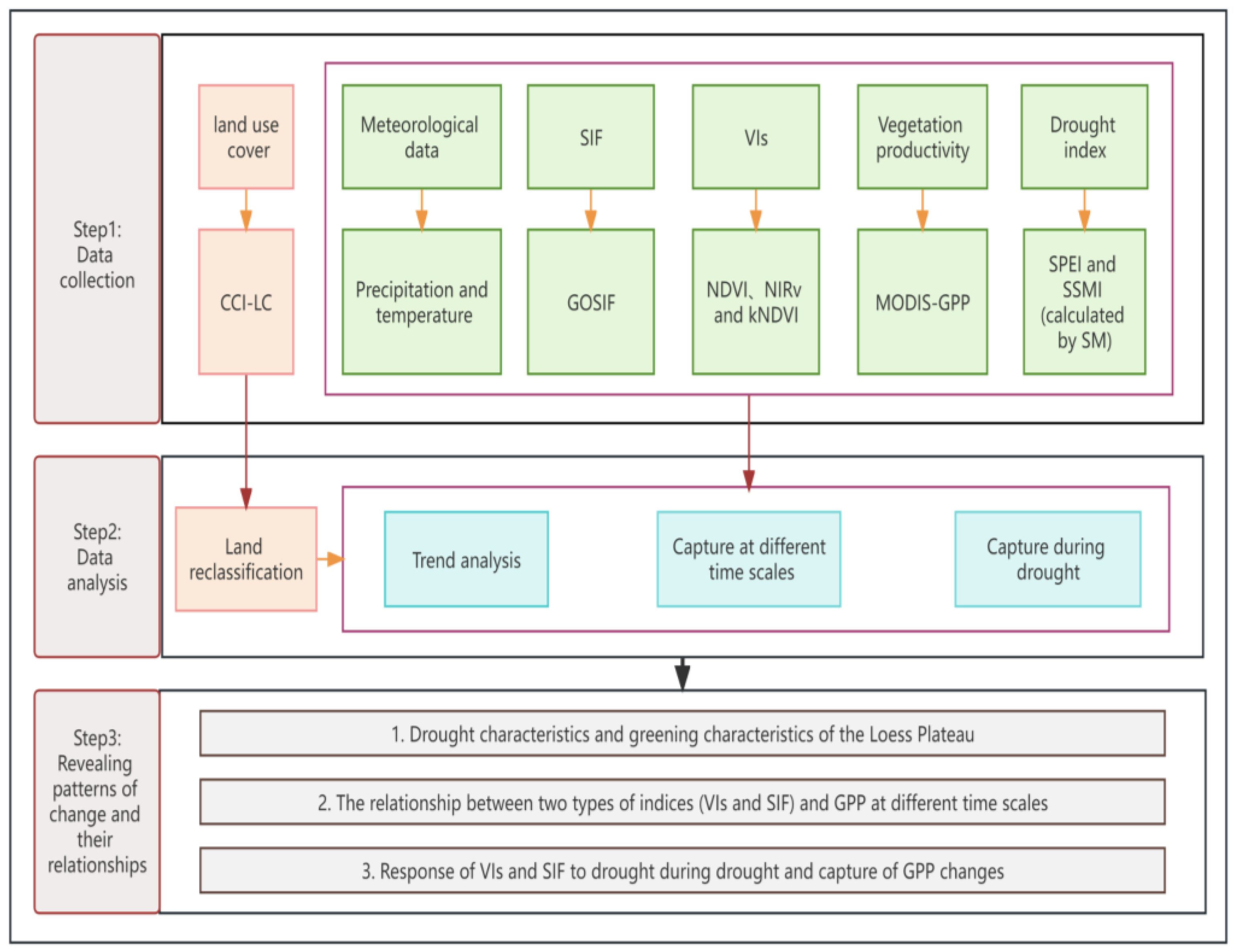

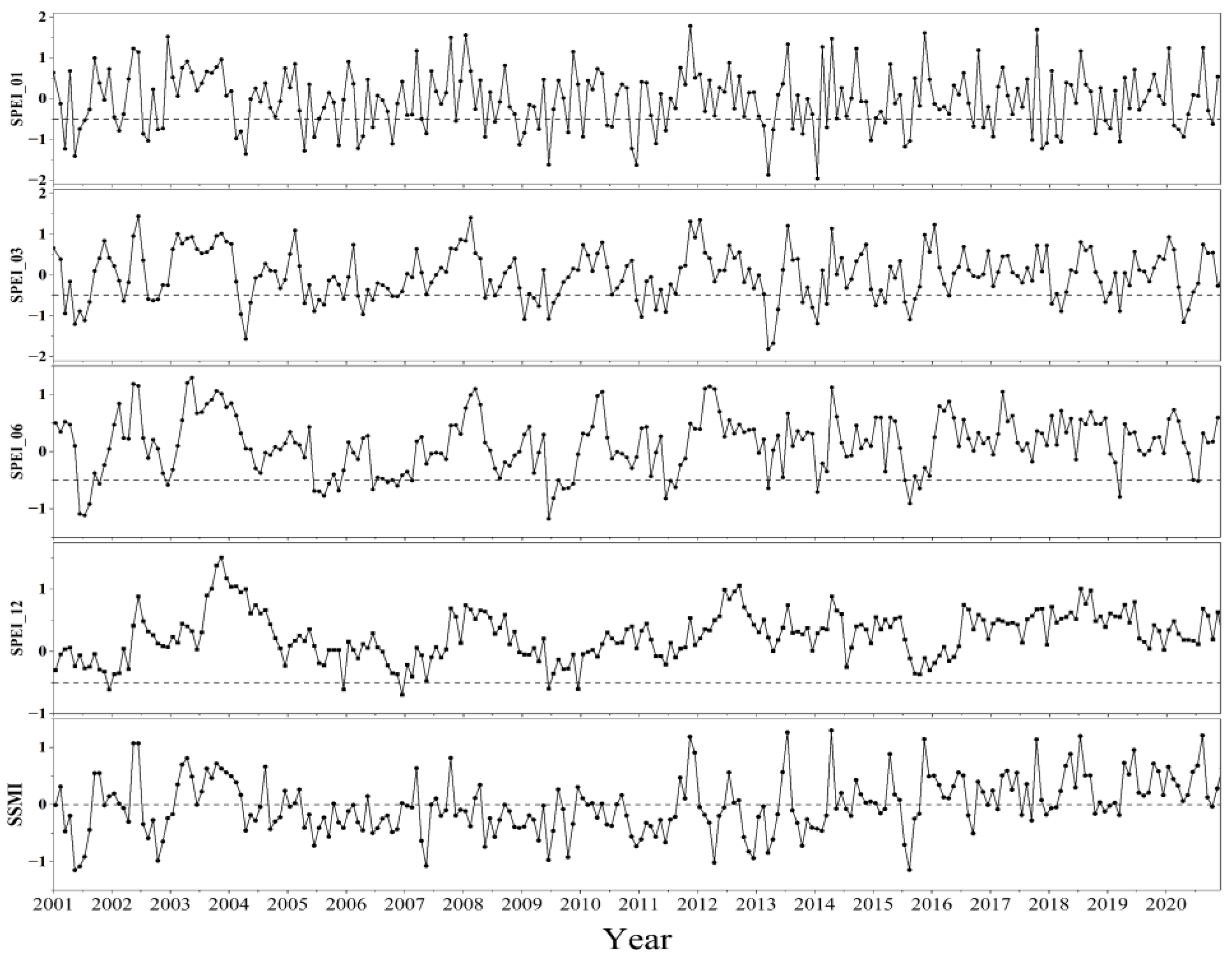
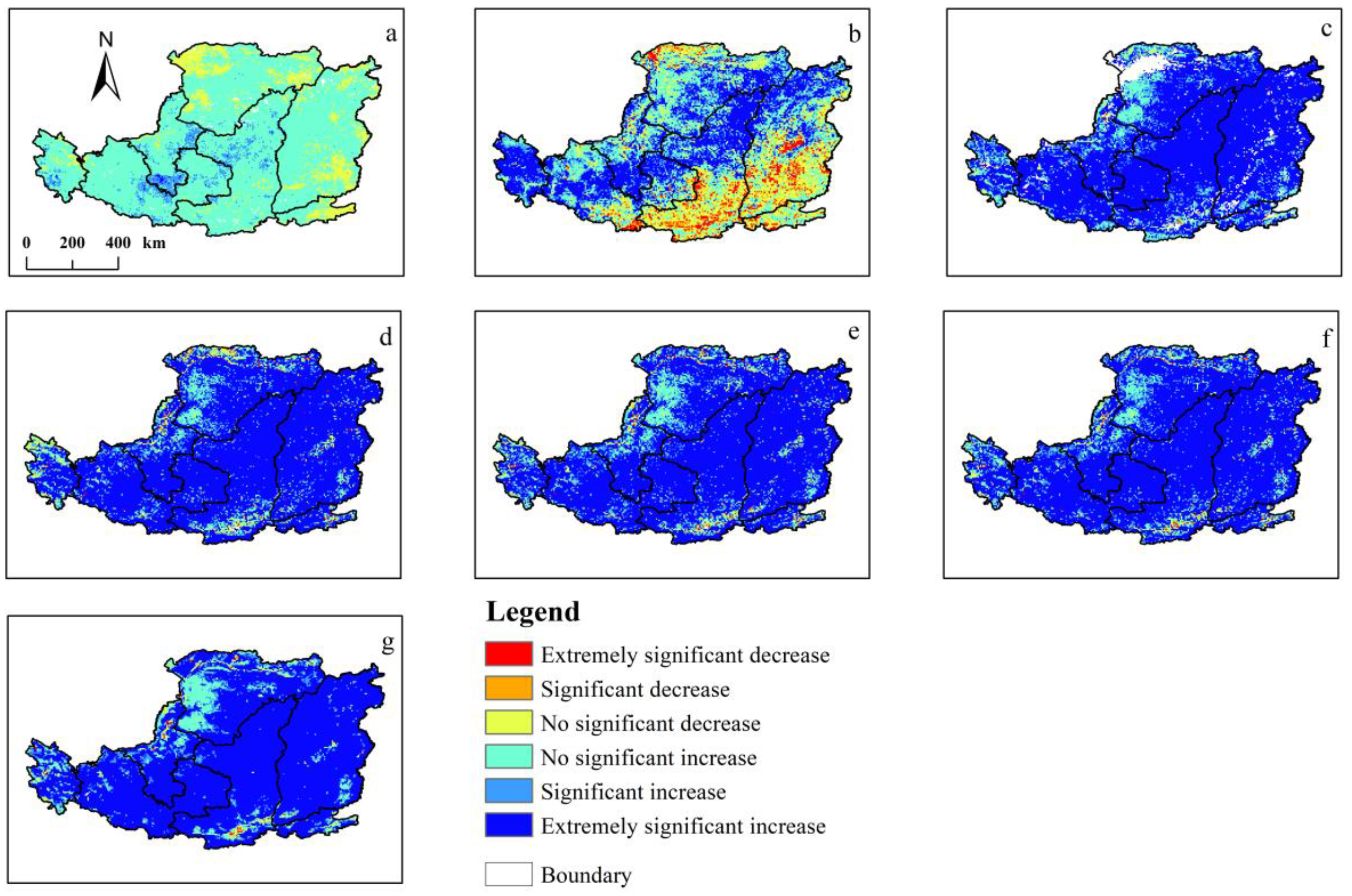
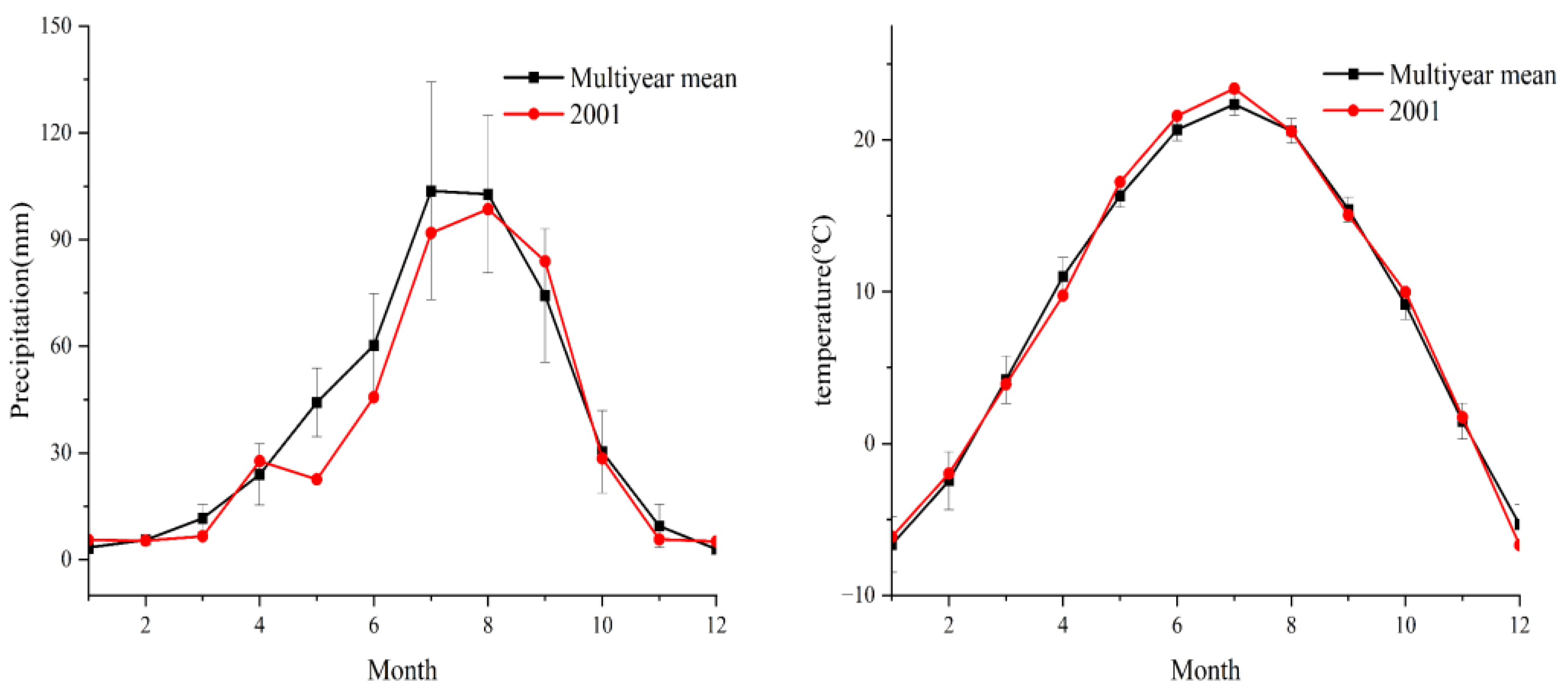
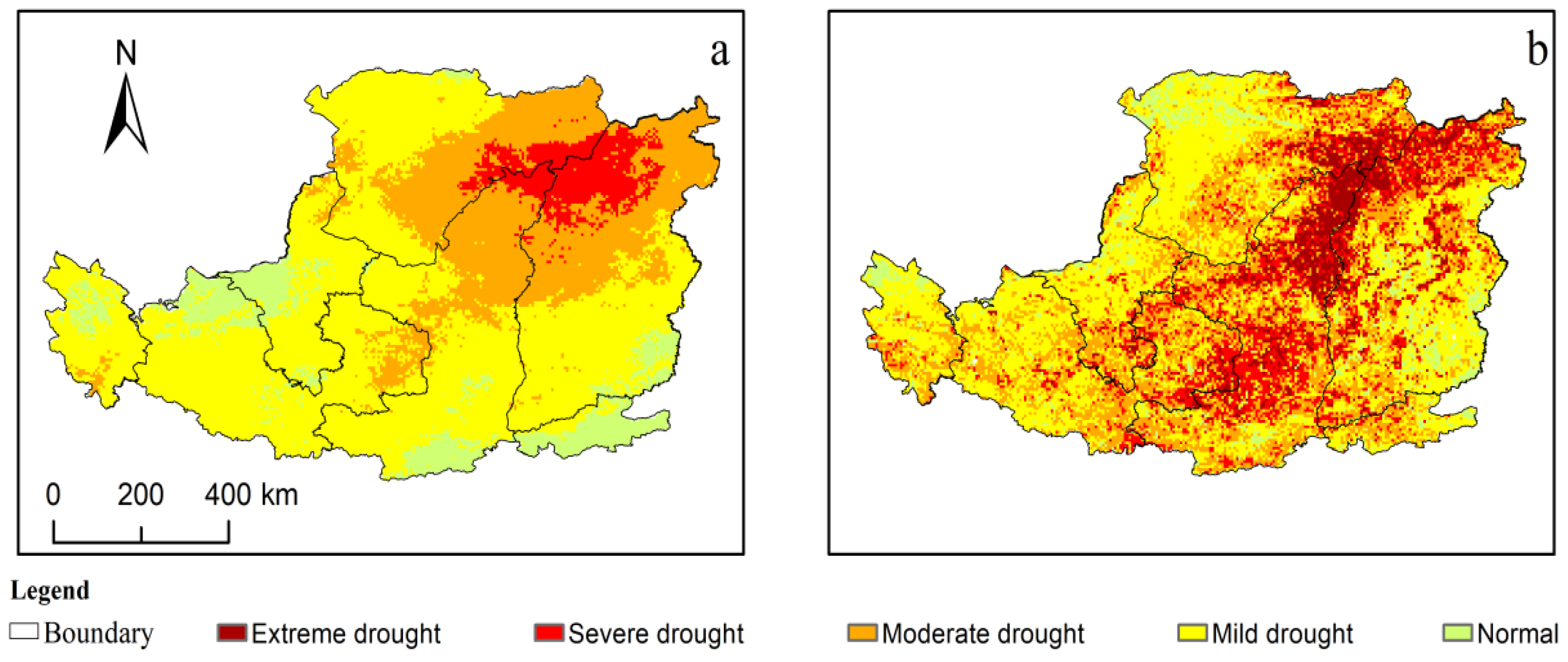
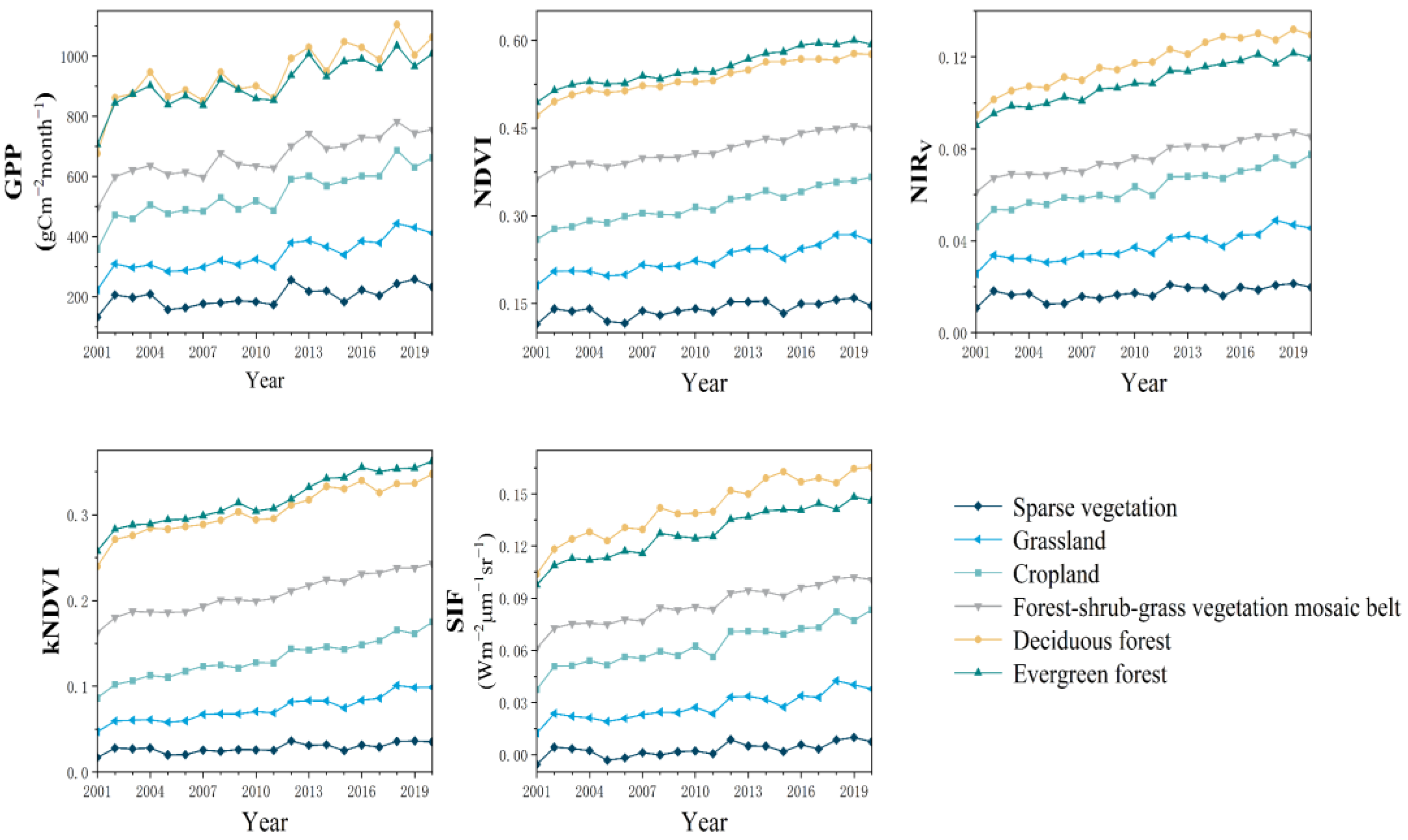
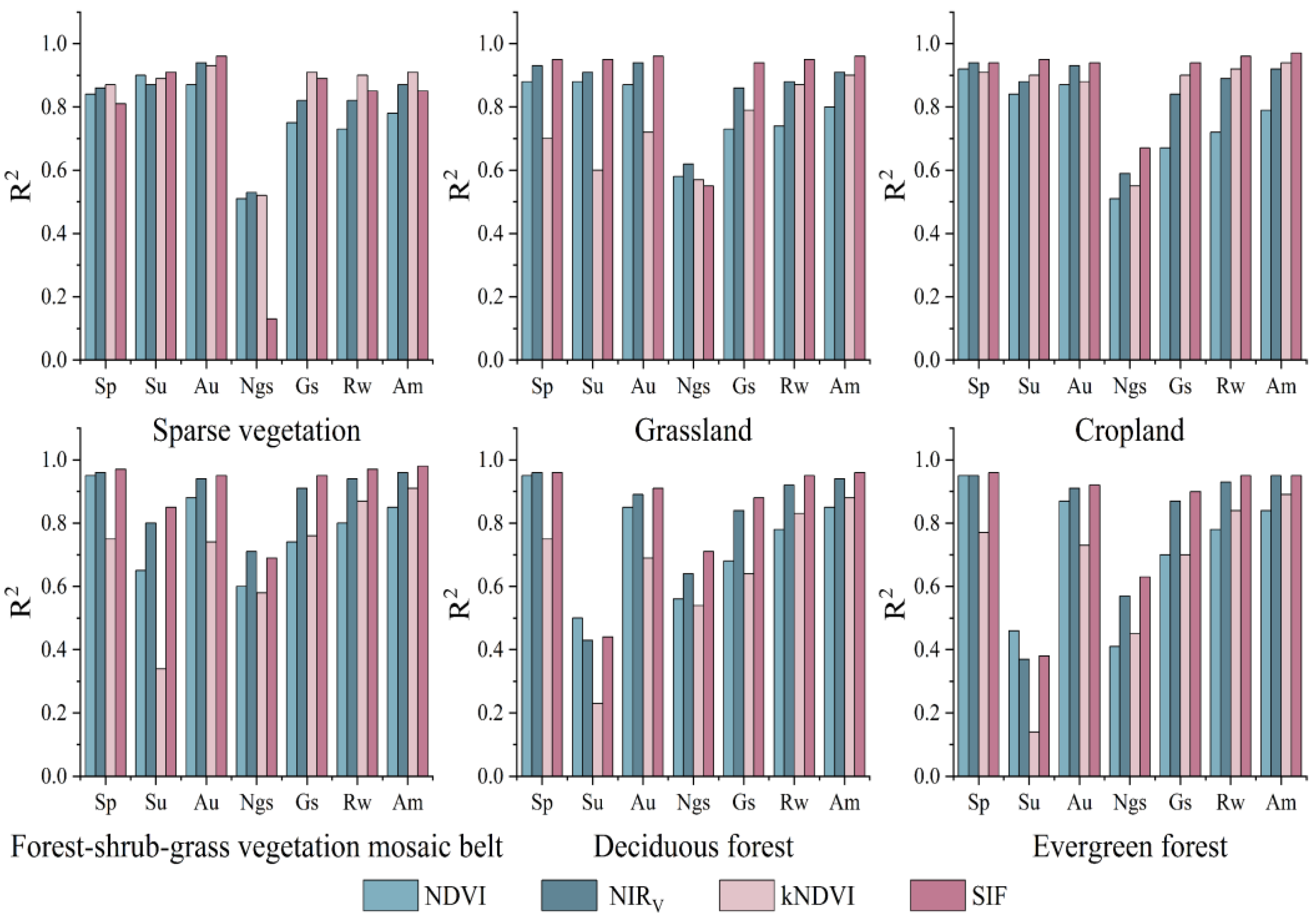

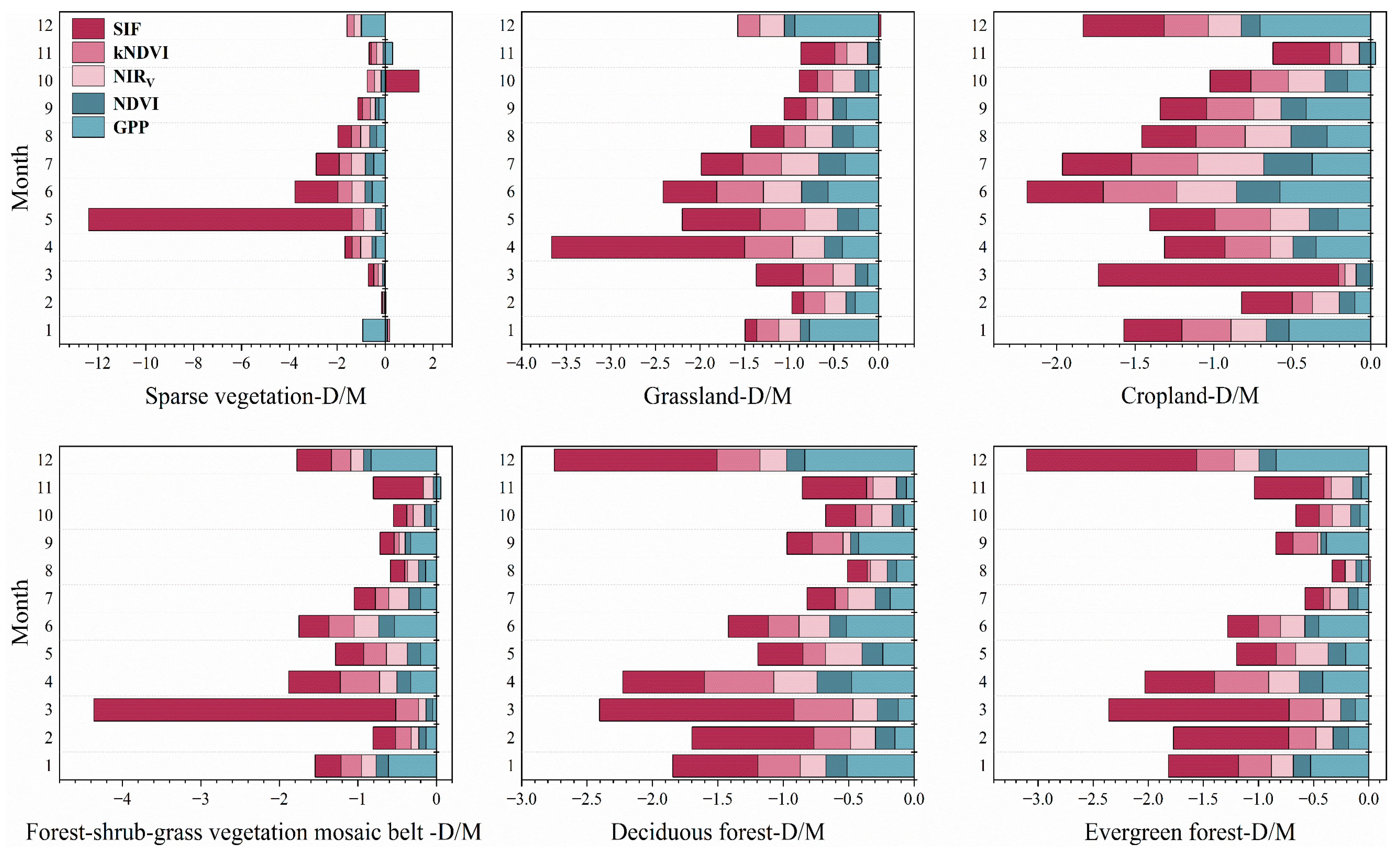
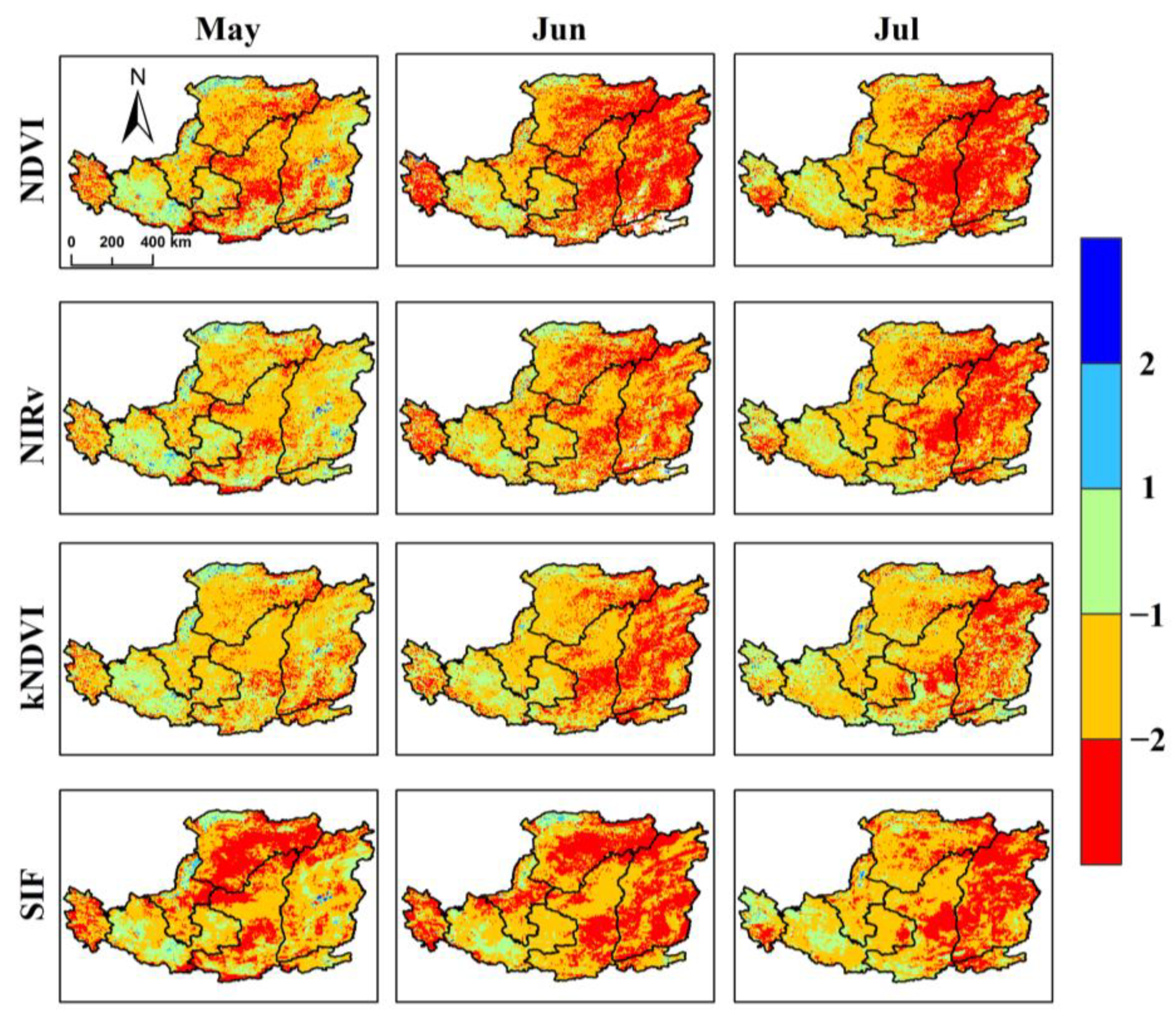
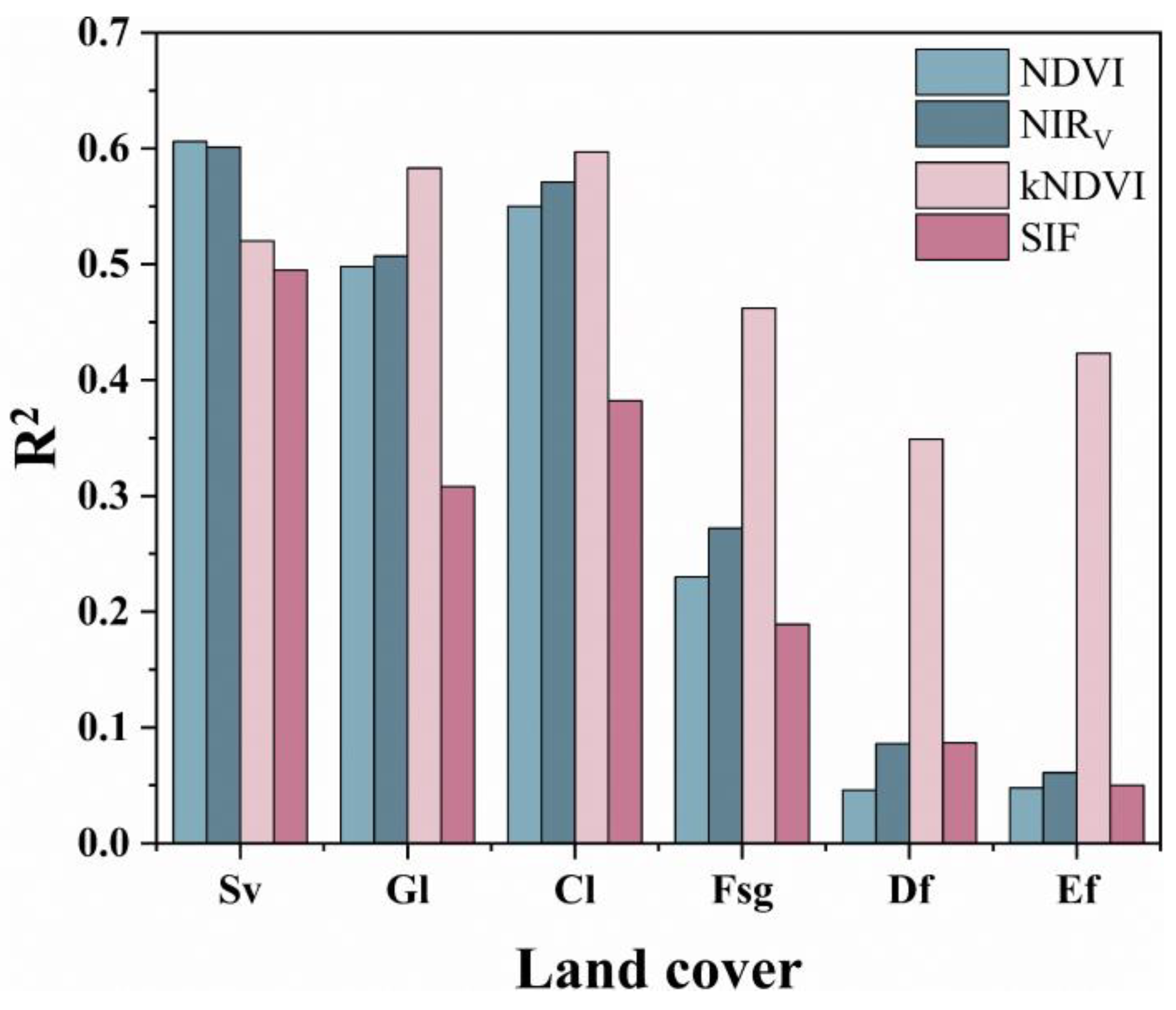
| SPEI | SSMI | Class |
|---|---|---|
| >−0.5 | >0 | No drought |
| −1.0–−0.5 | −1.0–0 | Mild drought |
| −1.5–−1.0 | −1.5–−1 | Moderate drought |
| −2.0–−1.5 | −2.0–−1.5 | Severe drought |
| ≤−2 | ≤−2 | Extreme drought |
| Anomaly | Class |
|---|---|
| >2 | Strong positive anomaly |
| 1–2 | Moderate positive anomaly |
| −1–1 | No anomaly |
| −1–−2 | Moderate negative anomaly |
| <−2 | Strong negative anomaly |
Disclaimer/Publisher’s Note: The statements, opinions and data contained in all publications are solely those of the individual author(s) and contributor(s) and not of MDPI and/or the editor(s). MDPI and/or the editor(s) disclaim responsibility for any injury to people or property resulting from any ideas, methods, instructions or products referred to in the content. |
© 2024 by the authors. Licensee MDPI, Basel, Switzerland. This article is an open access article distributed under the terms and conditions of the Creative Commons Attribution (CC BY) license (https://creativecommons.org/licenses/by/4.0/).
Share and Cite
Hou, X.; Zhang, B.; Chen, J.; Zhou, J.; He, Q.-Q.; Yu, H. Response of Vegetation Productivity to Greening and Drought in the Loess Plateau Based on VIs and SIF. Forests 2024, 15, 339. https://doi.org/10.3390/f15020339
Hou X, Zhang B, Chen J, Zhou J, He Q-Q, Yu H. Response of Vegetation Productivity to Greening and Drought in the Loess Plateau Based on VIs and SIF. Forests. 2024; 15(2):339. https://doi.org/10.3390/f15020339
Chicago/Turabian StyleHou, Xiao, Bo Zhang, Jie Chen, Jing Zhou, Qian-Qian He, and Hui Yu. 2024. "Response of Vegetation Productivity to Greening and Drought in the Loess Plateau Based on VIs and SIF" Forests 15, no. 2: 339. https://doi.org/10.3390/f15020339
APA StyleHou, X., Zhang, B., Chen, J., Zhou, J., He, Q.-Q., & Yu, H. (2024). Response of Vegetation Productivity to Greening and Drought in the Loess Plateau Based on VIs and SIF. Forests, 15(2), 339. https://doi.org/10.3390/f15020339




